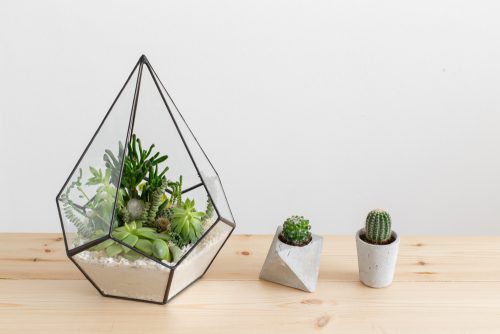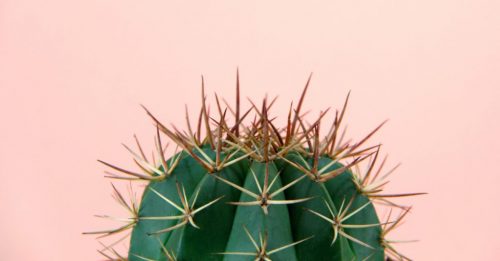Know the Different Types of Cacti

There are different types of cacti, which you can use to decorate your bedroom, kitchen, and garden. Knowing about them and their needs will help you choose the right ones to use in your home.
Cacti are super trendy right now. People love to give them as a souvenir at a wedding or use them to decorate their homes, gardens, balconies, restaurants, and stores. Although you may not believe it, there are many types of cacti and each one of them has their own characteristics.
We’ll tell you more about them in this article.
Their general characteristics
Cacti are increasingly appearing in houses, as they’re great to use for decoration, but they also serve other purposes. They’re great to look at, but they’re also perfect to use in your home because they require almost no maintenance. All you have to do is water them occasionally. They’re very easy to grow and there are plenty of varieties available.
All cactus species belong to the Cacteceae family and are native to America, except for the species Rhipsalis baccifera. These are succulents that you’d find in warm, desert, and tropical areas. You can grow them in Europe, Asia, and Africa, since they adapt to different environments very well. All they need is dry land and a good amount of sun every day. They don’t like excessive humidity in the air or in the ground!

To stay hydrated, cacti store water in their spines, located in the areola. The body is formed by a stem (almost always greenish) which can be cylindrical, flattened, or spherical. The cacti’s flowers are solitary and hermaphroditic. This means that they reproduce with each other without problems. As for the fruits, they’re generally in the form of a berry.
What types of cacti exist?
Succulents are a large family, and cacti are the most common and most popular. In addition, there are subspecies that people choose to decorate their homes. We’ll take a look at some of those now.
1. San Pedro Cactus
This plant’s scientific name is Echinopsis pachanoi and it’s native to the Andes, more precisely at altitudes between 1,000 and 3,000 meters above sea level in Peru and Ecuador. However, it’s easy to grow as long as it has fertile and well-drained soil. It can withstand the temperature changes of day and night, typical of a mountain climate.
The San Pedro cactus isn’t only used for decoration. The ancient American settlers believed it had medicinal benefits to treat nerves, the heart, infections, and joint disorders. It has elongated green stems and white flowers with a yellow center.
2. Mother-in-law seat cactus
Undoubtedly one of the types of cacti with the most curious name, it’s also known as ‘hedgehog’ or ‘golden barrel.’ In addition, it’s endemic to Mexico, but nowadays it grows in other areas of the world. It has a spherical shape, is bright green, and has yellow thorns.
The flowers that grow at the top are completely yellow. This plant requires special care, such as soil with a good substrate and drainage. It needs direct sunlight and an average temperature of 15 degrees Celsius all year round. You don’t have to water it in the winter. It will look great in a recycled flowerpot!

3. Barrel cactus
This plant is a direct relative of the previous cactus. It grows in the north of Mexico, between 1,150 and 1,850 meters above sea level. It’s a plant with a spherical shape and dark green color with several globule stems from which red, curve, and thick thorns protrude.
Finally, the barrel cactus has yellow flowers with a red center, black seeds, and succulent and dry fruits.
4. Tuna or nopal
This is one of the most well-known types of cactus. It’s a bush type, rustic and thorny cactus, which grows naturally mainly in Argentina, where it’s consumed and processed as candy. It also grows in Mexico. It even forms part of the flag and coat of arms of Mexico.
The prickly pear can grow in large size, is green, has a flattened shape, and rounded ends with very long, hard thorns. The flowers are yellow and the fruit has a very thick skin.
Additionally, there are other types of cactus that we can have at home, both inside and in our gardens. The Christmas Tree (Schlumbergera truncata), the pink flower (Mammillaria fraileana), the quince (Echinopsis chiloensis), the guacamacho (pereskia), the ramilloso mexicana (Coryphantha ramillosa), the button cactus (Epithelantha micromeris), and the white duraznillo (opuntia leucotricha). The latter has no thorns.
There are different types of cacti, which you can use to decorate your bedroom, kitchen, and garden. Knowing about them and their needs will help you choose the right ones to use in your home.
Cacti are super trendy right now. People love to give them as a souvenir at a wedding or use them to decorate their homes, gardens, balconies, restaurants, and stores. Although you may not believe it, there are many types of cacti and each one of them has their own characteristics.
We’ll tell you more about them in this article.
Their general characteristics
Cacti are increasingly appearing in houses, as they’re great to use for decoration, but they also serve other purposes. They’re great to look at, but they’re also perfect to use in your home because they require almost no maintenance. All you have to do is water them occasionally. They’re very easy to grow and there are plenty of varieties available.
All cactus species belong to the Cacteceae family and are native to America, except for the species Rhipsalis baccifera. These are succulents that you’d find in warm, desert, and tropical areas. You can grow them in Europe, Asia, and Africa, since they adapt to different environments very well. All they need is dry land and a good amount of sun every day. They don’t like excessive humidity in the air or in the ground!

To stay hydrated, cacti store water in their spines, located in the areola. The body is formed by a stem (almost always greenish) which can be cylindrical, flattened, or spherical. The cacti’s flowers are solitary and hermaphroditic. This means that they reproduce with each other without problems. As for the fruits, they’re generally in the form of a berry.
What types of cacti exist?
Succulents are a large family, and cacti are the most common and most popular. In addition, there are subspecies that people choose to decorate their homes. We’ll take a look at some of those now.
1. San Pedro Cactus
This plant’s scientific name is Echinopsis pachanoi and it’s native to the Andes, more precisely at altitudes between 1,000 and 3,000 meters above sea level in Peru and Ecuador. However, it’s easy to grow as long as it has fertile and well-drained soil. It can withstand the temperature changes of day and night, typical of a mountain climate.
The San Pedro cactus isn’t only used for decoration. The ancient American settlers believed it had medicinal benefits to treat nerves, the heart, infections, and joint disorders. It has elongated green stems and white flowers with a yellow center.
2. Mother-in-law seat cactus
Undoubtedly one of the types of cacti with the most curious name, it’s also known as ‘hedgehog’ or ‘golden barrel.’ In addition, it’s endemic to Mexico, but nowadays it grows in other areas of the world. It has a spherical shape, is bright green, and has yellow thorns.
The flowers that grow at the top are completely yellow. This plant requires special care, such as soil with a good substrate and drainage. It needs direct sunlight and an average temperature of 15 degrees Celsius all year round. You don’t have to water it in the winter. It will look great in a recycled flowerpot!

3. Barrel cactus
This plant is a direct relative of the previous cactus. It grows in the north of Mexico, between 1,150 and 1,850 meters above sea level. It’s a plant with a spherical shape and dark green color with several globule stems from which red, curve, and thick thorns protrude.
Finally, the barrel cactus has yellow flowers with a red center, black seeds, and succulent and dry fruits.
4. Tuna or nopal
This is one of the most well-known types of cactus. It’s a bush type, rustic and thorny cactus, which grows naturally mainly in Argentina, where it’s consumed and processed as candy. It also grows in Mexico. It even forms part of the flag and coat of arms of Mexico.
The prickly pear can grow in large size, is green, has a flattened shape, and rounded ends with very long, hard thorns. The flowers are yellow and the fruit has a very thick skin.
Additionally, there are other types of cactus that we can have at home, both inside and in our gardens. The Christmas Tree (Schlumbergera truncata), the pink flower (Mammillaria fraileana), the quince (Echinopsis chiloensis), the guacamacho (pereskia), the ramilloso mexicana (Coryphantha ramillosa), the button cactus (Epithelantha micromeris), and the white duraznillo (opuntia leucotricha). The latter has no thorns.







